Valdez
Above 3,000ftModerate
1,500 to 3,000ftModerate
Below 1,500ftModerate
Degrees of Avalanche Danger
Avalanche Problems
Problem 1
Strong northerly winds will continue through the morning before tapering in the afternoon. temperatures have increased overnight in some locations, but will begin to fall coinciding with the decrease in winds. It will be possible to trigger wind slab avalanches 1-2 feet deep on the lee side of ridges and terrain features in the maritime forecast zone. Smaller wind slabs have the potential to step down to deeper faceted layers in the snowpack, although this is not nearly as likely as it is for Thompson Pass and locations north. The most likely place to encounter this avalanche problem will be on the lee side of ridge lines and cross loaded gullies. Test slopes can be a good tool to utilize when assessing the sensitivity of windslabs.
Likelihood:
- Almost Certain
- Very Likely
- Likely
- Possible
- Unlikely
Size:
- Historic
- Very Large
- Large
- Small
Trend
- Increasing
- Steady
- Decreasing
Problem 2
There is a 1-3+ foot deep slab sitting on the November facets. These facets have continued to show easy to moderate propagation results in stability tests. Red flags such as shooting cracks, large collapses and natural avalanches have all been present in the Thompson Pass area lately. This has been observed to a lesser degree in the maritime forecast zone.
Very strong northeast winds have recently loaded lee aspects, further stressing facets in these areas. In areas exposed to wind, the slab overlying the November facets has variable depths. These range from scoured down to the facets (little to no slab) on windward aspects, to 2-4 feet deep on lee aspects (dense wind slabs). In areas exposed to recent winds the persistent avalanche problem is confined to specific areas (lee aspects). Persistent wind slab avalanches were naturally active as recently as 12/21. Triggering a persistent slab avalanche will be likely directly following major changes in weather, such as strong winds. The hazard will slowly decrease as we move further away from wx events, but will remain a dangerous possibility.
Persistent slab avalanche problems are tricky and require a lot of patience, and a conservative approach in choosing terrain. Good protocols are very important as well during this type of avalanche problem ie: only exposing one person at a time to an avalanche prone slope, good communication and having an escape route should a slope fail. It is possible to trigger avalanches remotely from flat terrain be aware of the terrain around you and the consequences of triggering a slope above you.
Photo of Remote triggered/sympathetic avalanches on 12/8
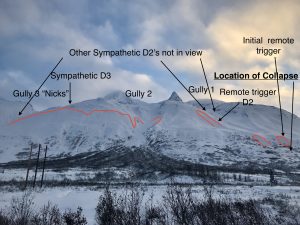
Likelihood:
- Almost Certain
- Very Likely
- Likely
- Possible
- Unlikely
Size:
- Historic
- Very Large
- Large
- Small
Trend
- Increasing
- Steady
- Decreasing
Avalanche Activity
12/21- Numerous natural avalanches observed all along the north side of Thompson Pass, as a result of strong NE wind event along with a couple inches of new snow and rising temperatures. Observed naturals on all aspects except windward slopes with crowns originating from 1000 feet to 5500 feet in elevation. Most of these were hard slab avalanches. Crown depths were difficult to discern due to reloading, although some crowns looked to be up to 2 meters in depth.
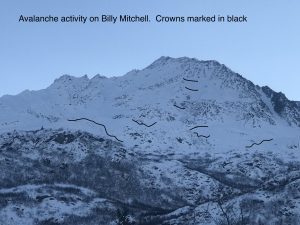
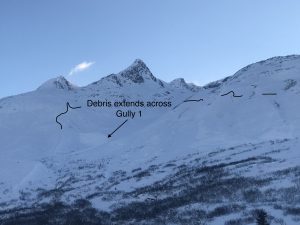
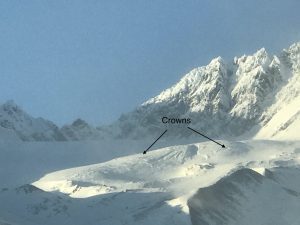
12/19- D 2.5 natural avalanches were observed on the north facing buttress west of Gully 1 and Schoolbus.
12/14- Several natural avalanches were observed although poor visibility prevented a full view of the action. The most notable natural was observed in Nicks Happy Valley on a NW aspect ~4000′. Crown depth was not visible. Debris ran down the valley and piled up at the typical snowmachine pickup.
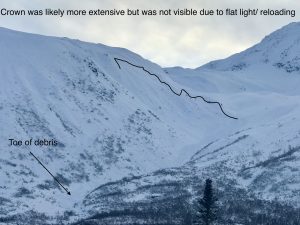
12/8- Large remote trigger/ sympathetic avalanche event occurred 12/8 with avalanches extending from Gully 1 to Nicks. Avalanches were soft slabs that ranged in size from D1-D3. Over 10 separate avalanches were counted with crown depths averaging 2-3′. One avalanche had a crown length of half a mile while another was triggered over a mile away from the point of collapse. See observation section for full report and more photos.

12/7- Only a few natural avalanches were noted during the last storm. It is likely there were more during the storm, but crowns may have been filled in by subsequent wind and snow.
D2’s on Town mountain was observed ~3000′
A couple of D2’s were noted in N. Oddessey gully and Big Oddessey.
D2 on 40.5 mile peak ~5500′.
12/2-12/3- Several natural D2 avalanches were noted on south aspects of Three pigs, Hippie Ridge and Averys. These windslab avalanches originated between 4000-5500 feet elevation.
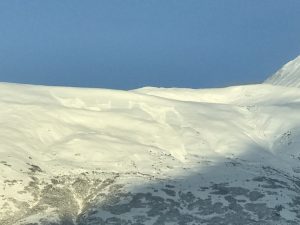
Weather
NWS Watches and Warnings
None
Point forecast for Thompson Pass
Detailed forecast for Thompson Pass (mid elevation 2000-4000′)
DATE FRIDAY 12/24 SATURDAY 12/25
TIME (LT) 06 12 18 00 06 12 18 00 06
CLOUD COVER FW FW SC OV BK OV OV OV OV
CLOUD COVER (%) 10 20 30 80 55 70 80 75 90
TEMPERATURE 14 14 9 7 7 14 14 16 21
MAX/MIN TEMP 15 5 15 13
WIND DIR NE NE NE NE NE NW NW NW SW
WIND (MPH) 29 25 19 10 5 2 3 4 5
WIND GUST (MPH) 57 46 27 23
PRECIP PROB (%) 0 0 0 5 10 10 10 5 30
PRECIP TYPE S
12 HOUR QPF 0.00 0.00 0.00 0.00
12 HOUR SNOW 0.0 0.0 0.0 0.0
SNOW LEVEL (KFT)0.0 0.0 0.0 0.0 0.0 0.0 0.1 0.3 0.7
Snow and Temperature Measurements
| Date: 12/24 | 24 hr snow | HN24W* | High Temp | Low Temp | Weekly SWE (Monday- Sunday) | December Snowfall | Season Snowfall | HS (Snowpack depth) |
| Valdez | N/O | N/O | 25 | 7 | .12 | 55 | 79 | 22 |
| Thompson Pass | N/O | N/O | 19 | 8 | .2 | 39 | 159 | 24 |
| 46 Mile | Trace | 0 | 24 | 0 | .25 | 30 | 30** | 20
|
All snowfall measurements are expressed in inches and temperature in Fahrenheit. 24 hour sample period is from 6am-6am.
* 24 hour snow water equivalent/ SWE.
** Season total snowfall measurements for 46 mile began December 1st.
Season history graphs for Thompson Pass
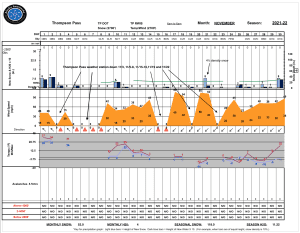
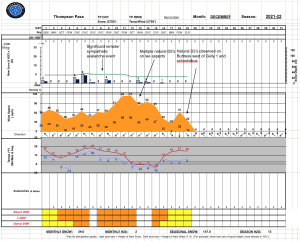
Click on links below to see a clear and expanded view of above Season history graphs
Additional Information
Winter weather began early this season, with valley locations receiving their first snowfall on the last day of Summer (September 21st). Following this storm, above average temperatures and wet weather occurred from late September through early November. During this time period Thompson Pass received 96 inches of snowfall by November 7th and Valdez recorded 7.73″ of rain.
After the 7th of November our region experienced a sharp weather pattern change. Temperatures dropped below seasonal norms and snowfall became infrequent. Between the time frame of November 7th- November 28th Thompson Pass only reported 19″ of snow with 1.1″ of Snow water equivalent (SWE). Temperatures remained below 0° F for most of the period. This cold/dry weather caused significant faceting of the snowpack, with poor structure the result.
Moderate snowfall returned to our area the last day of November and deposited 6-12 inches of new snow. The amount varied depending upon the locations’ proximity to the coast. As the storm exited on the 2nd of December it was quickly replaced by moderate to strong northeast winds.
On 12/5-12/6 Valdez received 2 feet of new snow with Thompson Pass reporting 16″. Blaring red flags like collapsing, shooting cracks and propagation in stability tests were immediately present. On 12/8 a significant remote/ sympathetic avalanche event occurred from Gully 1 through Nick’s Happy Valley.
Strong outflow winds began on 12/11 with periods of light snowfall. This has caused slab thicknesses to become variable in areas exposed to NE winds.
A fair amount of natural avalanche activity occurred during the 12/11 wind event mostly on southerly aspects. The week following this wind event fairly benign weather occurred which allowed the snowpack to adjust and for stability to improve although snowpack structure has remained poor.
On 12/21 our area received a couple inches of snow along with temperatures rising and strong outflow winds. This combination of weather kicked off a fairly significant natural avalanche cycle. Many of the slabs appeared to be deeper wind slabs that were created from the 12/11 wind event. These failed on faceted snow created in November. The event is yet another indicator of our poor snowpack structure and its inability to receive any major change in weather without the avalanche hazard rising in conjunction.
Announcements
Click the + Full Forecast button below for a list of current avalanche problems, travel advice, weather resources and more.
Help to improve your local avalanche center and contribute an observation to the website. You can also contact me directly at [email protected] (907)255-7690.

